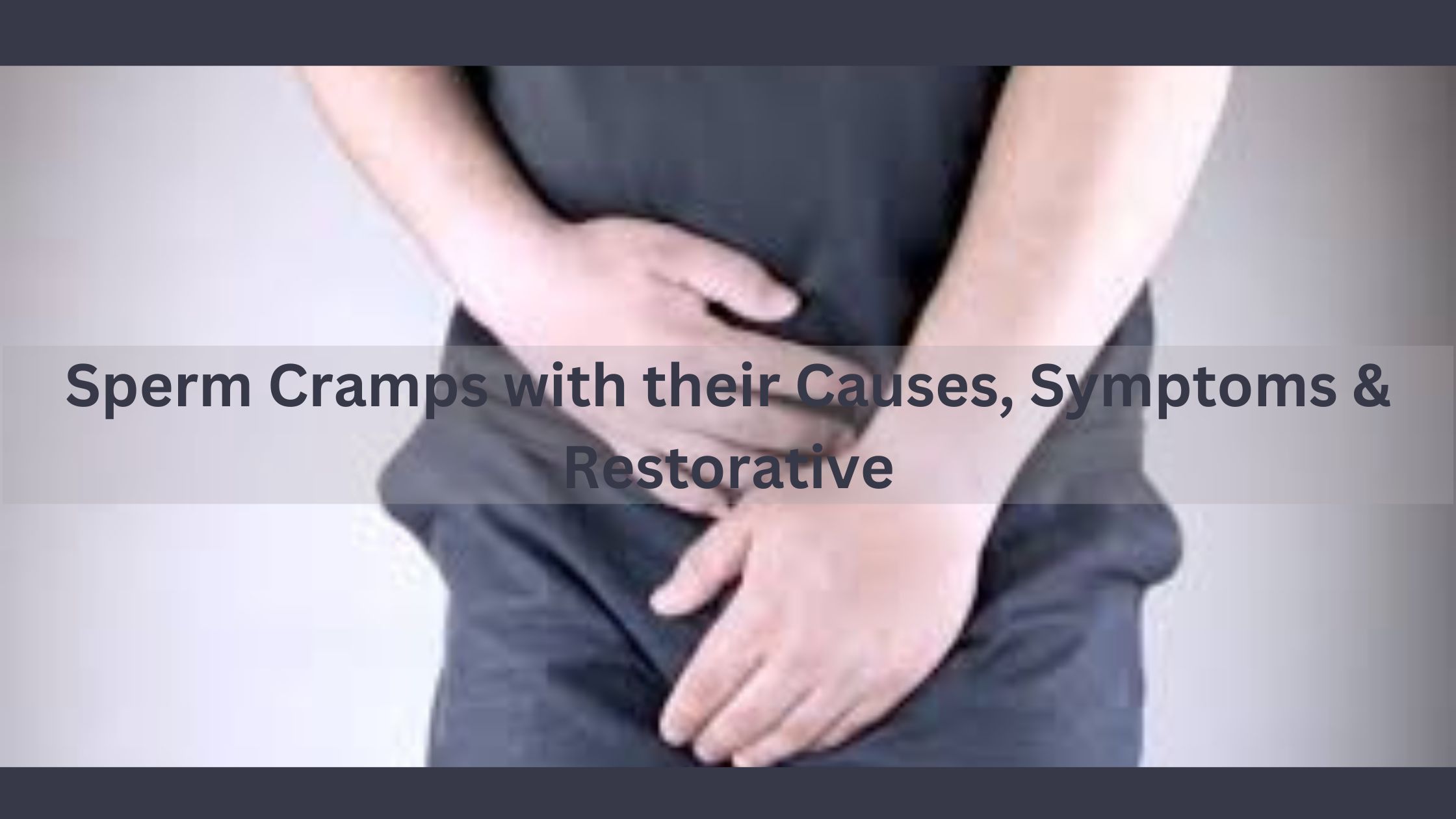When it comes to male fertility, there is a vast ocean of information, but some topics still need to be clarified. Today, we will shed light on one of these topics: sperm cramps. What do we mean by sperm pain? Do men feel it? If so, how is it going? These questions and more will be addressed in our in-depth research below.
Also known as epididymal hypertension, epididymal hypertension is recognized as an uncomfortable and painful sensation that some men experience after orgasm.
Being a taboo subject, not everyone is well informed about the pathology, and the constant lack of awareness affects a large part of the population, affecting the quality of daily life.
To shed light on this taboo subject and educate you about sperm pain, we will discuss symptoms, causes, diagnosis, and treatment to provide valuable information to men with health issues. But before we get into the detailed information about sperm cramps, let’s understand how they are defined medically.
What are Sperm Cramps?
It’s natural to know that everyone’s body responds differently to sexual stimulation and orgasm. While some people experience pleasure and relief, others may experience pain and discomfort related to orchids. Medically known as post-orgasmic pain syndrome (POPS), basal cramps are a reaction some men may experience after ejaculation.
In medical terms, “sperm cramps” refers to a condition called testicular pain or testicular discomfort that usually occurs after ejaculation. Discomfort may manifest as pain or cramping in the testicle or surrounding area. The severity of this condition can range from mild discomfort to severe pain and paralysis.
Ejaculatory spasms can occur alone or be triggered by specific activities such as ejaculation, sexual desire, or vigorous activity. Understanding the underlying causes of sperm pain is important to obtain proper medical awareness and advice.
Why do Sperm Cramps Happen?
Psychological factors such as anxiety, stress, and depression can increase the risk of seizures. On the other hand, physical factors such as prolonged abstinence, vigorous sexual activity, and hormonal imbalances can also contribute to sperm pain.
| Condition | Symptoms | Causes | Treatment |
| Prostatitis | Pain or discomfort in the pelvic area, lower back, or genital area | Bacterial infection, nerve damage, injuries, or hormonal changes | Antibiotics, anti-inflammatory agents, pain relievers |
| Varicocele | Aching pain when standing or sitting for long periods, feeling of heaviness or swelling in the scrotum | Inefficient valves within the veins of the spermatic cord | Supportive underwear, pain relievers, surgery if necessary |
| Epididymitis | Pain and swelling in the testicle(s), fever, urethral discharge | Bacterial infection, often related to a urinary tract or sexually transmitted infection | Antibiotics, rest, scrotal elevation, cold packs |
| Sperm Buildup | Abdominal or testicular pain, discomfort during ejaculation | Prolonged sexual inactivity | Regular ejaculation, supportive underwear, warm baths |
Common Causes of Sperm Cramps in Men
It is surprising to know that sperm pain can range from mild discomfort to severe pain that lasts not only for hours but also for several days. Yes, the exact cause of sperm cramps is still unknown, but researchers have found that the most common causes of male infertility are:
- Infection: Genital infections, such as epididymitis (inflammation of the epididymis) or urinary tract infections, often cause pain or cramping.
- Epididymitis and Orchitis: Orchitis and epididymitis, two infections that affect the testicles, can cause swelling and discomfort. These illnesses may require medical treatment, which may include antibiotics, and are often caused by a bacterial infection.
- Testicular Torsion: This is a medical emergency that occurs when the scrotum twists, cutting off blood flow to the testicles. To prevent long-term testicular damage, this disease causes severe and intense testicular discomfort and requires immediate medical attention.
- Muscle tension: You may experience cramps or discomfort during sexual activity due to excessive tension or contractions.
- Post-orgasmic illness syndrome (POIS): It is a rare condition that causes various symptoms, including muscle pain, fatigue, and discomfort after ejaculation.
- Repetitive Strain: Cycling or horse riding are activities that can cause discomfort because they put repeated pressure on the groin area. Wearing supportive clothing and taking breaks from these activities can reduce symptoms.
- Trauma or Injury: Testicular discomfort can be the result of injury to the reproductive organs, accidents, or injuries. Even minor injuries can cause discomfort and pain if left untreated.
- Varicocele: These are the veins of the scrotum which are hypertrophied. Although there are often no symptoms, it can cause pain or discomfort in the testicles, especially during physical activity.
- Prostate issues: Conditions such as prostatitis (inflammation of the prostate) or an enlarged prostate can cause discomfort or pain during ejaculation.
- Other factors: Various factors can affect sperm spasms. Psychological factors such as anxiety, stress, and depression can increase the risk of seizures. On the other hand, physical factors such as prolonged abstinence, vigorous sexual activity, and hormonal imbalances can also contribute to sperm cramps.
Male Sperm Cramps Symptoms
Ejaculatory cramps are characterized by sharp or dull pain in one or both testicles after ejaculation. This pain can be complex and its intensity can vary. In some cases, men have also experienced visions in the groin, lower abdomen, or perineum. In many cases, it is difficult to walk.
Early diagnosis and early warning are important to avoid serious problems such as male infertility. We’ve made it so that sperm cramp symptoms are tracked in a category like this:
Psychological Symptoms
These are some very important psychological symptoms that you should know:
- Increased Stress
- Sexual Performance Anxiety
- Psychosomatic Factors
- Psychological Trauma
Physical Symptoms
These are some very important physical symptoms that you should know:
- Pelvic Pain
- Intense Pain
- Abdominal Pain
- Pain During Sex
- Inflammatory Diseases
- Structural Abnormalities
- Accumulation of Sperm
- Ejaculatory Duct
- Redness and Swelling in the Scrotum
- Fever and Chills
- Blood in Semen or Urine
- Discharge from the Penis
- Nausea and Vomiting
It is important to remember that testicular pain can be uncomfortable and painful but is usually not cause for concern if diagnosed early. However, if you continue to ignore it and the swelling or fever persists, it will be important to consult a doctor before these sperm cramps become a cause of male infertility.
Causes of Sperm Cramps
Let us know about all the causes of sperm cramps.
- Bacterial infections – Doctors often recommend antibiotics if testicular pain is caused by bacterial infections, such as epididymitis or orchitis. Even if your symptoms improve, you should complete the full course of treatment to ensure the infection is completely gone.
- Pain management – Over-the-counter pain relievers such as ibuprofen or acetaminophen can help relieve mild to moderate ankle pain. Always follow your doctor’s instructions and seek medical advice, especially if you have other health conditions or are taking other medications.
- Warm compresses – Warm compresses can reduce pain and relax the muscles in the affected area. Do not use high heat to avoid burns.
- Surgical intervention – Surgery may be necessary to treat problems such as a slipped or herniated disc. Testicular torsion needs rapid surgery to convert blood flow to the testicle.
- Physical Therapy – Physical therapy exercises and procedures can help reduce pain and prevent further chronic injuries caused by muscle strains or repetitive trauma.
How to Diagnose Spermatic Cramps?
Sperm cramps are usually diagnosed by evaluating the patient’s symptoms and medical history. A physical examination may be performed to detect the condition of the testicles or epididymitis. Depending on the severity of your symptoms, your fertility specialist may recommend additional diagnostic tests, such as an ultrasound, MRI, and CT scan to examine the internal structures of the testicles.
Additionally, fertility specialists can diagnose sperm cramps by:
- Medical background
- Physical test
- Clinical tests
The question now is: is there a way to prevent and treat sperm pain naturally?
The answer is yes. You can fight this battle by making a few lifestyle changes. To better understand, we have created a list for you.
When to Consult a doctor in case of Spermatic Cramps?
If you are seeing or understanding the symptoms of sperm cramps in yourself, then you should not consider it as a simple problem, it can create a lot of problems in your married life due to which you may have to bear mental and physical pressure, hence you should If you see any symptoms, consult your doctor or any other doctor without wasting your time or without delay.
- Sudden, intense pain, redness, or swelling.
- The pain persisted for several hours.
- Seminal bleeding and feeling cold.
- Heat and cool.
- A change in the size or shape of the testicles.
- Pain during ejaculation or urination.
There is nothing to be ashamed of, this is human life and every human life has some kind of ups and downs.
What lifestyle changes can you make to prevent testicular Cramps?
You can take the following effective prevention steps:
- Wear supportive underwear.
- Managing increasing stress levels.
- Clear communication with your partner.
- Drink a lot of water.
- Avoid excessive ejaculation.
- Address your emotional concerns.
- Avoid alcoholic beverages and tobacco.
Always consult a doctor for the best course of action.
Conclusion
Men’s reproductive health is a broad field with many nuances. When we bring attention to issues like sperm cramps, we enable a conversation that leads to a better understanding of the male reproductive system. Remember that if you feel any discomfort or pain, it is necessary to contact a specialist. With proper counseling and treatment, these problems can be managed effectively, ensuring a healthy reproductive life.


